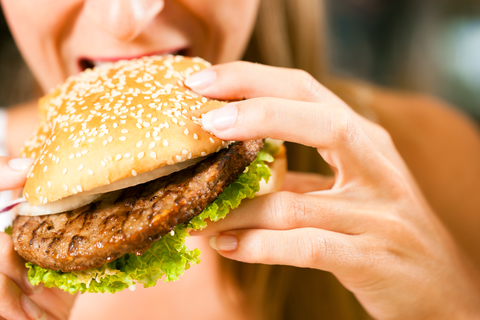Is There Such a Thing as Healthy Fast Food?
When you’re hungry and on the run, fast food can really hit the spot. It’s quick, tasty, and, best of all, convenient. But it’s also loaded with calories, sugar, sodium, and fat—often enough in one meal for an entire day or more. And if you’re feeding your whole family, it can be expensive, too—often more so than cooking at home. Is there such a thing as healthy fast food?
Fast food menus are tricky when you’re watching your weight or your health. Finding a healthy, well-balanced meal in most fast food restaurants is a challenge. But there are always healthier options hidden among the diet disasters. You just need to know where to look and how to order.
The first thing to establish is that there are many things that can make a meal unhealthy. A vegetarian soup might be low in calories, but packed with salt and sugar. A veggie wrap might skip the red meat in favor of healthy pulses and beans, but if it’s also slathered in cheese and mayo, or a super sweet barbecue sauce, it’s not going to do our arteries any favor.
The following tips and menu recommendations can help you stay on track. Just remember that even the healthy fast food options often have nutritional drawbacks so try to keep fast food to the occasional treat.
- Aim to keep your entire meal to 500 calories or less. The average adult eats 836 calories per fast food meal—and underestimates what they ate by 175 calories. So don’t guess! Most chains post nutritional info both on their websites and at the franchise location. Take advantage of this information.
- Opt for foods that are lower in fat and higher in protein and fiber. Look for items with more good stuff, like fiber, whole grains, and high-quality protein. Also aim for options that are relatively low in saturated fats.
- Steer clear of trans fats. Small amounts of naturally-occurring trans fats can be found in meat and dairy products but it’s the artificial trans fats used to keep food fresh that are dangerous to your health. Avoid anything containing “partially hydrogenated” oil—even if it claims to be trans fat-free—or any foods that have been deep fried. While no amount of artificial trans fat is considered safe, the USDA recommends at least limiting trans fat to no more than 2 grams per day.
- Keep an eye on sodium intake. The American Heart Association recommends that adults stay under 1500 mg of sodium per day, and never take in more than 2,300 mg a day. That can be tough to do when eating fasting food—a burger and fries can easily exceed your daily limit.
- Bring your own add-on items if you really want a health boost. Even when you order wisely, it can be pretty tough to get enough fiber and other important vitamins and nutrients from a fast food menu. If you plan ahead, you can bring healthy sides and toppings like dried fruit, nuts and seeds, carrot sticks, apple or pear slices, and cottage cheese or yogurt.
Beware of added sugar
One of the biggest problems with fast food is the amount of added sugar—and it’s not just in sodas or desserts. Even the average burger contains 5 to 10 grams or more of added sugar, about the same as a couple of cookies. Salad dressings, ketchup, dips, and BBQ sauces are also packed with added sugar.
When you opt to eat at a fast food chain, try to plan ahead if possible and eat low sugar in the meals leading up to and following your fast food meal. You can minimize some of the damage by requesting salad dressing on the side, limiting ketchup, eating subs, burgers or sandwiches open-faced, and skipping dips or sides that are packed with sugar.
Healthy fast food ordering guidelines
- Keep your eye on portion size. Many fast food meals deliver enough food for several meals in the guise of a single serving. Avoid supersized and value-sized items, and go for the smallest size when it comes to sandwiches, burgers, and sides. You can also find more reasonable portions on the children’s menu.
- Focus on grilled or roasted meats. Avoid fried and breaded items, such as crispy chicken sandwiches and breaded fish fillets or processed meats such as sausage, bacon, hot dogs, or ham. Choose turkey, chicken breast, or roast beef instead.
- Pay attention to the descriptions on the menu. Dishes labeled deep-fried, pan-fried, basted, batter-dipped, breaded, creamy, crispy, scalloped, or au gratin are usually high in calories, unhealthy fats, and sodium. Same with items in Alfredo or cream sauce.
- Don’t be afraid to special order. Many menu items can be made healthier with a few tweaks and substitutions. For example, you can ask to hold the sauce or dressing or serve it on the side. Or you can request a wheat bun for your hamburger or whole-grain bread for your sandwich.
- Don’t assume that healthy-sounding dishes are always your best option. For example, many fast food salads are a diet minefield, smothered in unhealthy dressing and fried toppings. This is where reading the nutrition facts before you order can make a huge difference.
“Is There Such a Thing as Healthy Fast Food?”, Written for Vertex Fitness Personal Training Studio by Ashvini Mashru, RD
Request a complimentary first session at Vertex Fitness, Voted the BEST Personal Training Studio on the Main Line
Click HERE and we will schedule a session to try it yourself








Leave a Comment